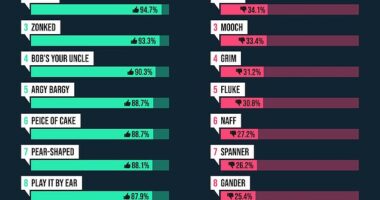Last week, Netflix released its 18-episode animated anthology Love, Death + Robots, a decidedly NSFW series that adapted a number of short stories from well-known science fiction authors. It’s clear from watching the series that there’s a nearly endless supply of source material out there for another season, if Netflix green-lights one. While we wait to see whether that happens, we’ve rounded up some recommendations for a good season 2, and we’ve got 17 recommendations that you can read online now (along with a couple of deep cuts that you’ll have to hunt for.)
Love, Death + Robots’ episodes are often heavy on the violence and body horror. One story in that range is Charlie Jane Anders’ “Don’t Press Charges and I won’t Sue,” which was published in Boston Review’s Global Dystopias in 2017. Set in the near future, it follows a woman who’s kidnapped by an ultra-conservative organization that tries to forcibly “fix” her gender. Another good one to consider from Anders is “The Minnesota Diet,” a satirical story about food scarcity in a futuristic city.
:no_upscale()/cdn.vox-cdn.com/uploads/chorus_asset/file/15980762/_collid_books_covers_0_isbn_9780262535427_type_.jpg)
Also, every couple of years MIT publishes Twelve Tomorrows, a special fiction-filled edition of its Technology Review. These collections are always worth reading, but Elizabeth Bear’s story “Okay, Glory” (later reprinted in Lightspeed Magazine) is particularly good. It features an eccentric tech billionaire who accidentally gets trapped in his smart home when it’s infected with ransomware.
The 1970 anthology Science Fiction Hall of Fame contains a number of classic stories that would lend themselves well to a Love, Death + Robots 2. One good example is “Surface Tension” by James Blish, originally published in 1952 in Galaxy Magazine. It isn’t officially published online, but here’s a scanned copy of the magazine, courtesy of the Internet Archive. The story is about an expedition from Earth that crash-lands on an aquatic planet. With no hope of rescue, the survivors engineer tiny descendants, who eventually become sophisticated enough to develop their own spacecraft-like ships to explore the world beyond the water’s surface.
:no_upscale()/cdn.vox-cdn.com/uploads/chorus_asset/file/15980771/story3.jpg)
Last year, Clarkesworld Magazine published “Wings of Earth” by Chinese science fiction author Jiang Bo. The story is about a pair of astronauts — one Chinese, one American — who explore a massive alien ship that suddenly appears in orbit around Earth. It’s a trippy story that with overtones of 2001: A Space Odyssey, and it would make for a particularly great animated short.
Love, Death + Robots also features some zany episodes, so here’s one that might fit in there: Brooke Bolander’s Uncanny Magazine story “The Tale of Three Beautiful Raptor Sisters and the Prince Who Was Made of Meat” is a fun one about a princess who befriends three velociraptors, who eventually eat the dim-witted prince who’s trying to control her.
Keeping in mind that robots play a big part of this show, an excellent story to adapt would be Ted Chiang’s Lifecycle of Software Objects, a fantastic novella about a scientist raising a pair of robots to sentience. The story was originally published as a hardcover book, but Subterranean Press also published it online. It’s long since been taken down, but you can find it via the Internet Archive. It’ll also be included in Chiang’s new collection, Exhalation, which is due out in May. The title story is also well worth reading.
:no_upscale()/cdn.vox-cdn.com/uploads/chorus_asset/file/15980773/cityborngreat_full.jpg)
N.K. Jemisin is responsible for a number of really brilliant novels, but her 2016 story for Tor.com, “The City Born Great,” would make for an excellent animated short. It’s about a graffiti artist who discovers he’s the physical embodiment of New York City, and has to fight off an existential, otherworldly threat. It’s dynamic, epic, and extremely colorful.
One story that’s stuck with me for years is Geoffrey A. Landis’ “The Long Chase.” It’s set in a distant future where the last robotic survivor of a war attempts to escape from its enemy, a chase that takes centuries, across the solar system and beyond.
Love, Death + Robots did already adapt Ken Liu’s “Good Hunting,” but there are plenty of other stories from his back catalog that might fit. The story that first comes to mind is “The Paper Menagerie,” about a biracial child coming to terms with his identity via some fantastical origami. Another excellent one to consider is “Mono No Aware,” about the crew of a starship struggling to fix their damaged spacecraft after Earth is struck by an asteroid.
I’m a big fan of Karin Lowachee’s short fiction — you might remember a story of hers in our own digital anthology, Better Worlds. Since Love, Death + Robots featured a bunch of stories that focused on mechs and military science fiction, her Nomad would be a good fit. It’s about a sentient mech coping with the loss of a beloved pilot, and running into a gang of rogue mechs in the wastelands of Canada.
:no_upscale()/cdn.vox-cdn.com/uploads/chorus_asset/file/15980782/9200000093376141.jpg)
Clarkesworld Magazine also published Chelsea Muzar’s “Not Now” last year. It’s short, but has an intriguing premise: a giant mech arm falls from the sky and onto a teenager’s house. She’s left to cope with the fallout: discrimination from her neighbors and classmates who were already suspicious of robots.
Linda Nagata’s short story for Tor.com, “The Martian Obelisk,” earned a Hugo nomination last year, and it’d lend itself well to animation. An architect has devoted her life to a project at the behest of a tech gazillionaire who wants her to build a monument to humanity on Mars. It’s meant to outlast us, but she runs into complications when she discovers that a long-assumed-dead colony still has survivors.
A great short story that came out last December is Annalee Newitz’s “When Robot and Crow Saved East St. Louis,” which was published in Slate. A health bot goes from house to house as part of a government program to monitor neighborhoods for infectious diseases like the flu. When the government privatizes its program, it continues its work on its own, with the help of a flock of crows.
Love, Death + Robots’ trio of John Scalzi adaptations show off how well his super-short stories adapt to the screen. In that vein, a piece he published to his blog Whatever last December, “An Interview with Santa’s Lawyer,” might make a really fun animated short, if only because it includes the line “I’ve seen Santa out of uniform. That dude is ripped.”
It’s also worth tracking down stories that haven’t made their way online. Love, Death + Robots did some deep dives into old collections and anthologies, and found a bunch of short fiction that was worthy of attention.
:no_upscale()/cdn.vox-cdn.com/uploads/chorus_asset/file/15980785/IAS_2003_02_Pilcerova.jpg)
Karen Traviss is probably best known for her Star Wars and Gears of War novels, but her short fiction is pretty great as well. “Suitable for the Orient,” which appeared in Asimov’s Science Fiction back in February 2003 (and is included in her short story collection View of a Remote Country), takes its title from a saying from the British Empire — below-par doctors were frequently shipped out to Asia. In this story, such a doctor has has to deal with the native near-sentient aliens on a planet after human hunters kill some of them.
“The Waste Land” by Charles Sheffield might be harder to track down, as it only appears to have been published in the March 2003 issue of Asimov’s Science Fiction. It’s still worth reading if you have the option. It focuses on a security guard who’s called into a nuclear-waste facility to investigate the death of a worker who suffered from unbelievable radiation burns. In the process, he discovers a mysterious experiment and a cover-up. This one feels like it’d be particularly suited for a noir-ish art style.
Another couple of entries from the Science Fiction Hall of Fame anthology would make good animated shorts. The first is Murray Leinster’s “First Contact,” about a human spaceship coming into contact with an alien counterpart, and having to figure out how to exchange information without either of them tipping off the other about the location of their homeworlds. Another is “Microcosmic God” by Theodore Sturgeon, about a brilliant scientist who develops a tiny civilization in his lab and rapidly advances their evolution and technology by continually killing off generations.
Finally, given Love, Death + Robot’s frequent use of cats, Arthur C. Clarke’s story “Who’s There?” seems like a perfect fit. It’s a fun story about an astronaut who discovers some unexpected passengers while on an EVA.
This article is from The Verge









